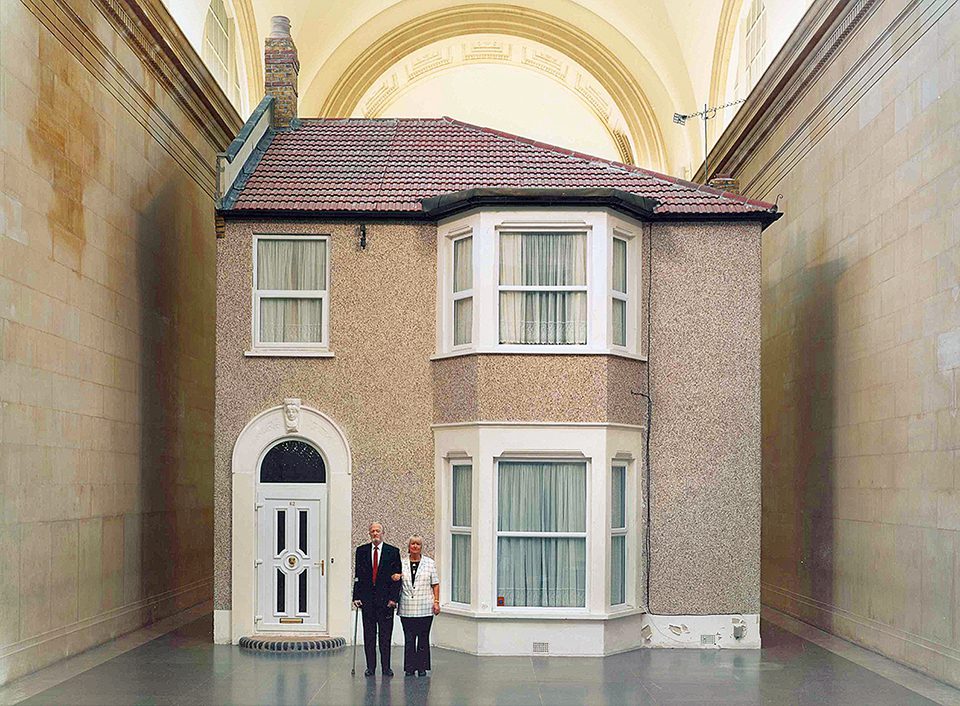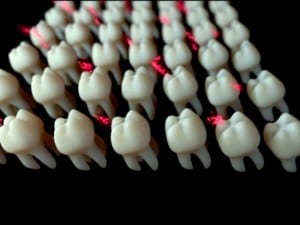A new book by Jeremy Cooper surveys the 25 year success and phenomenon that was, and in many ways still is, the Young British Artists. Since the 1990s there has not been an artistic movement with such relevance and prominence; we look back to understand why.
The late 1980s in Britain were tumultuous times defined by innovation, social and economic change, and the implementation of new (and old) political policies, with Margaret Thatcher winning her third term as Conservative Prime Minister in 1987. Just two years later, in 1989, Tim Berners-Lee invented the World Wide Web, to forever change the world as we know and understand it. The young aspiring artists studying at Goldsmiths in London during the late 1980s, colloquially known as the “YBAs” (Young British Artists), were defined by this era in which they studied and, for most of them, had a direct impact on their career. Five of these artists – Anya Gallaccio, Damien Hirst, Gary Hume, Michael Landy and Sarah Lucas, have been chosen by the writer Jeremy Cooper as the focus of his new book Growing Up, to be released by Prestel this April. The book emphasises the intertwining relationships, both personal and working, between these artists since the seminal 1988 student-run exhibition Freeze. It has been almost 25 years since Freeze and each of these artists has experienced mainstream and critical success, coming to be known both within the art world and to the general public.
Michael Glover argues (The Independent, February 2009) that the YBAs “became shockingly famous and absurdly rich – due, in part, to their brilliant ability to promote themselves.” This is precisely the sort of misconception that Cooper tries to refute in Growing Up, for it was their ability to work and play with the media that enabled them to survive and to continue producing work on the scale that they have done. Each recognises the role that the media has played in their success, and though some, such as Lucas, have chosen to step away from this (she resides in relative seclusion with her partner in the Suffolk countryside), others (Hirst in particular) have wholeheartedly embraced it.
The book is an authoritative, focused examination of the working practice of these five artists as well as of their professional and personal histories, utilising firsthand accounts, archived records, interviews and texts to compile an all-encompassing overview of each of the artists. Growing Up is structured into 11 chapters, with five of these devoted entirely to each of the five artists. Cooper approached the book as a personal biographical account, meant to correct misconceptions within the media, and he “specifically avoids ‘sensational’ coverage of these artists; they were supportive of my approach, content to correct public inaccuracies with actual-life reality.” Michael Archer argues (in Thames & Hudson’s Art Since 1960) that the YBA phenomenon was often detrimental to the artists included in the collective, as the public’s overall understanding of their work “tended to obscure the very real differences between the ideas and attitudes of the artists, and made it hard to think of their work as being more than symptomatic of the grind of the media machine.”
Cooper therefore takes it upon himself to chart their evolution as artists and friends over the past 25 years, stating: “It is as human beings that these makers interest me, expressed through my wish to understand the personal qualities and circumstances as individuals that made them set out to become artists and, more significantly, how they have managed to sustain this activity for more than 20 years where so many others have been unable to, often painfully and sometimes tragically. I’ve tried to do this by description rather than in didactic telling.” This reference to the tragic is integral to the text for, though Cooper does not dwell on it at length, each artist has an element of tragedy in their own life which has altered the course of their work. With Landy, several personal experiences are paramount, one of which was being diagnosed with testicular cancer in 2004. Landy took that experience and vividly articulated it through a series of drawings of his scarred crotch: Radical Orchidectomy for a Solid Mass in the upper pole of the Left Testicle (2005), a coloured pencil drawing from the series, is detailed and gentle in its rendering of the scar, belying the potentially life-threatening element of the cancer.
Landy uses the tragedies of his own life as a source of inspiration in his work, in much the same way that Tracey Emin does in hers. Emin’s seminal 1995 work, Everyone I Have Ever Slept With 1963-1995, which was exhibited at the Carl Freedman curated exhibition Minky Manky at the South London Gallery, revealed a diaristic element that would come to define her oeuvre. Rather than shy away from her past, and any mistakes and tragedies implicit in it, Emin chose to invite her audience to share it with her. Her work is a strange concoction of complete vulnerability combined with an envious element of confidence and openness: a combination rarely seen in art. However, a recent article by Natasha Garnett in the Wall Street Journal on Emin posed the question: “Could it be the enfant terrible of the British art scene has finally grown up?” Indeed this question could be applied to the majority of the YBAs, as they have all, in recent years, matured as artists as well as individuals.
Goldsmiths’ students were encouraged to use their own life experiences in their artistic practice and perhaps the two most common tragedies, in the sense that they affected each artist, were the suicides of two friends and contemporaries, Factual Nonsense founder Joshua Compston in 1996, and the artist Angus Fairhurst in 2008. Compston’s death resonated throughout the Goldsmiths’ group and the YBAs in general, as he had been an avid supporter and organiser of, and often participant in, their work. A Fête Worse Than Death, a street festival organised by Compston in 1993 and 1994, had encouraged the playful, collaborative aspects of many of the group, with Gillian Wearing, Gavin Turk, Gary Hume and Sarah Lucas being but a select portion of the participating artists. These events were without financial benefit to Compston as Cooper argues that “the principal beneficiaries of Compston’s convictions were the artists themselves. They performed for each other, together made their own fun, as yet oblivious to public reaction.” His death, though tragic, seemed only to spur the YBAs on, none wanting to forget him and the influence he had had upon them and their development as artists. David Cohen’s obituary in The Independent describes him as “obsessed with finding ways of reaching beyond the precious confines of the art world.” This being specifically what the YBAs aspired to, one can see why Compston had such an all-encompassing influence. Over 10 years later the death of Fairhurst, just a day after the close of his solo exhibition at Sadie Coles Gallery, marked a definitive end to the playful sensibility of the previous 15 years: the artists found themselves, all of a sudden, quite grown-up.
The importance of Goldsmiths is highlighted throughout the text as being an integral aspect of their artistic development, specifically under the tutelage of Jon Thompson, the Dean of Fine Art at the time, who allowed them the freedom to experiment with different media and practices, thereby exposing them to the idea that artistic practice can be fluid, innovative, unfamiliar, and above all personal. Gallaccio’s installations are indicative of this shift away from convention and tradition, with the use of perishable materials such as oranges, flowers and tree trunks as the base material of these works. Intensities and Surfaces (1996), an installation at the Wapping Pumping Station, consisted of 34 tons of ice and a half-tonne boulder of rock salt, which slowly melted away leaving behind only traces of dried salt. The medium quite literally became the message for Gallaccio.
It was not an easy journey, with Freeze, the infamous 1988 exhibition curated by Damien Hirst being a turning point for many of the student artists. Cooper states that: “The fundamental difference between this group of five artists and other Goldsmiths graduates was Freeze, mounted in three separate parts in the summer of 1988 in the Port of London Authority’s disused gymnasium down on Surrey Docks.” The exhibition included 16 artists, many of whom today could be considered household names, for instance Mat Collishaw and Ian Davenport. The exhibition, as Cooper points out, was not considered significant at the time and very few people took the time and energy to trek to the space. Two years later Hirst, along with Carl Freedman and Billee Sellman, mounted three exhibitions at an old factory in Bermondsey (Building One), and it is this series of exhibitions which concretised the trajectory of these young artists – up.
This sense of initiative, entrepreneurship, and an overriding optimism in the art market rippled through the art world with subsequent artist-run shows being staged by other key figures such as Tracey Emin and Sarah Lucas with The Shop in 1993, the artist-run space City Racing in 1988, and Joshua Compston’s Factual Nonsense in 1992. The gallery space was still important, however especially the support of gallerists such as Karsten Schubert (who established his own gallery in 1987 after previously working with the Lisson gallery), Maureen Paley (who initially set up a gallery in her own home in 1984), and foundations such as Artangel, established by James Lingwood, which helped stage and fund Rachel Whiteread’s House in 1993 and Landy’s Breakdown in 2001.
The financial benefits of mainstream success is neither dismissed nor ignored by Cooper, though he does not dwell on it: “The operations of the art market per se are of little interest to me, or indeed to them [the five artists].” He goes on to argue that these are of peripheral concern to the YBAs: “Even artists like Gavin Turk, much of whose work is keyed to ‘name’ and market, or Damien Hirst who is semi-obsessed with ideas of branding, live their own independent lives, Turk choosing to leave White Cube and manage all his own affairs from his studio, and Hirst doing much the same, albeit in a more business-oriented style. And Gallaccio, Hume, Landy and Lucas do what they choose with barely a thought for the market place, private or public, grateful to their dealers for taking responsibility for all of this.”
The art market is notoriously fickle and variable, yet each of these artists has continued to maintain more than just a modicum of success, perhaps none more so than Damien Hirst. He quickly identified the potential of his art, and that of his contemporaries, to make money. Again, it was never the driving force behind his work, but it was a benefit that he was insistent on capturing and maintaining. Beautiful Inside My Head Forever, Hirst’s two-day auction at Sotheby’s in September 2008, comprised solely his own work (typically an auction comprises of secondary market works rather than primary), and was a groundbreaking affair as the first time an artist had stepped away from their gallery support network and gone directly to the auction house in order to sell their work. 97% of the works sold, making it a resounding success. This success has been deemed by some critics as short-lived; a 2010 article from the Economist states that by 2009 Hirst’s annual auction sales had shrunk by 93% (from $270m in 2008 to $19m the following year). The main criticism was that Hirst, by trying to control the market, had oversaturated it, and he faced scathing criticism. Robert Hughes stated in a 2008 Guardian article that it was “No wonder so many business big-shots go for Hirst: his work is both simple-minded and sensationalist, just the ticket for newbie collectors who are, to put it mildly, connoisseurship-challenged and resonance-free.”
Unlike his contemporary, ex-commodities broker Jeff Koons, who acutely and openly used art as a commodity, Hirst is much more subtle. The writer and critic Tony Godfrey comments that “Koons’ great originality was in turning himself – the artist – into the object of his art” and, in many ways, this is exactly what the YBAs have done: they have taken their own personal histories and relationships as the creative basis of their work.
These five artists did not exist in isolation, as they supported and worked alongside numerous other practising artists, including Rachel Whiteread, Gavin Turk, and Sam Taylor-Wood. Growing Up provides a fresh, informative, and personal glimpse into the lives and machinations of the five, providing a timeline of sorts to chart their success and development. It avoids, unlike so many other overviews of the period, dabbling in the “suspected” motivations and dives right in, finds them, and offers them up for the reader’s consumption.
Niamh Coghlan





